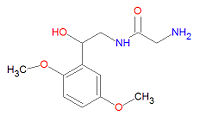Midodrine
Midodrine, or midodrina or midodrinum, is an ethanolamine derivative that is an adrenergic alpha agonist used as a vasoconstrictor agent in the treatment of hypotension (low blood pressure). It is sold under the brand name ProAmatine®. One of its major metabolites, desglymidodrine, formed by the desglycination of midodrine, is an alpha1-agonist and is the active substance associated with this drug. In patients with orthostatic hypotension, it raises the systolic and diastolic blood pressure in standing, sitting and supine positions. Activation of the alpha-adrenergic receptors in the arteriolar and venous vasculature increases vascular tone and elevates the blood pressure. It does not stimulate cardiac beta-adrenergic receptors. Symptoms of overdose include hypertension, goosebumps, urinary retention and a sensation of coldness. Its chemical IUPAC name is 2-amino-N-[2-(2,5-dimethoxyphenyl)-2-hydroxyethyl]acetamide, and its chemical formula is C12H18N2O4.
Drug interactions
Although increased arterial pressure occurs when this drug is used in combination with many other drugs, possible hypertensive crisis can occur when taken with tranylcypromine, rasagiline, phenelzine and isocarboxazid. Less dangerous increases in arterial pressure may occur when taken in combination with:
- Betamethasone
- Cortisone acetate
- Dexamethasone
- Dobutamine
- Dopamine
- Ephedra
- Ephedrine
- Epinephrine
- Fenoterol
- Fludrocortisone
- Hydrocortisone
- Isoproterenol
- Mephentermine
- Methoxamine
- Metaraminol
- Methylprednisolone
- Norepinephrine
- Orciprenaline
- Paramethasone
- Phenylephrine
- Prednisolone
- Prednisone
- Pseudoephedrine
- Pirbuterol
- Phenylpropanolamine
- Procaterol
- Salbutamol
- Terbutaline
- Triamcinolone
External Links
- Midodrine - FDA approved drug information (drug label) from DailyMed (U.S. National Library of Medicine).
- Template:MedMaster
- Template:DrugBank
